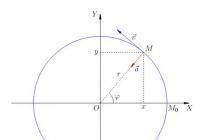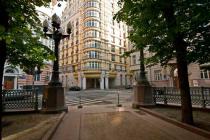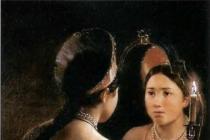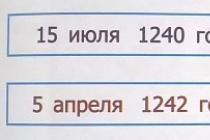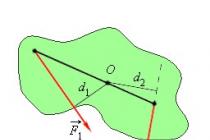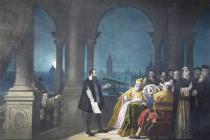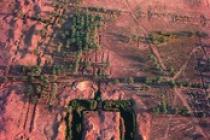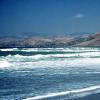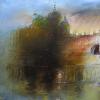1. Draw a red pencil around the border of Russia at the beginning of the 13th century.
Mark on the map with arrows the path of Batu Khan across Russia.
2. Write down the dates when Batu Khan attacked the cities.
Ryazan- end of 1237
Vladimir - in February 1238
Kiev- in 1240
3. Read a poem by N. Konchalovskaya.
Previously, Russia was specific:
Each city is separate,
Avoiding all neighbors
The appanage prince ruled,
And the princes did not live amicably.
They would need to live in friendship
And one big family
Defend your native land.
I would be afraid then
Horde attack them!
Answer the questions:
- What does an appanage prince mean? By the middle of the 12th century, Russia split into separate principalities, which were ruled by appanage princes
- How did the princes live? The princes did not live amicably, there were civil strife.
- Why weren't the Mongol-Tatars afraid to attack the Russian lands? The Russian princes were unable to unite to repel the enemy due to the fragmentation of the Russian principalities.
4. Relate the battle to its date.

5. Read the description of the battle on Lake Peipsi.
The Russians fought violently. And how not to fight without rage, when children and wives are left behind, villages and cities are left, there is a native land with a short and sonorous name Rus.
And the crusaders came as robbers. But where there is theft, there is cowardice alongside.
Fear took the knight-dogs, they see - the Russians are pushing them from all sides. Heavy equestrians cannot turn around in a crush, do not break free. And then the Russians started using hooks on long poles. Hook up a knight - and off the horse. He crashes on the ice, but he cannot get up: it hurts awkwardly in thick armor. And then his head was gone.
When the carnage was in full swing, the ice suddenly crackled under the knights and cracked. The crusaders went down, pulled on their heavy armor.
Until that time, the crusaders did not know such a defeat.
Since then, the knights looked to the east with fear. They remember the words spoken by Alexander Nevsky. And he said this: "".
(O. Tikhomirov)
Answer the questions:
- Why did the Russians fight violently? They defended their native land
- Why was it difficult for the cavalry of the crusaders in battle? The Crusader horsemen were heavy and clumsy.
- What did the Russians use the hooks for? They hooked the knights with hooks and pulled them off the horse.
- What words of Alexander Nevsky did the knights remember? Underline these words of the Russian prince in the text. Remember them.
The world. 4th grade.
Topic: "Difficult times on the Russian land."
Target: * Generalization of knowledge about difficult times in Russia;
- to consolidate knowledge of the heroic pages of the history of the Fatherland;
- develop the ability to work with the map, in groups, in the MSS, PPP;
- foster love for the Motherland;
- check the mastery of skills independently in the complex to apply ZUN, carry out their transfer to new conditions.
Lesson type: Training lesson generalization and systematization of ZUN.
Equipment: handout, map, projector.
Themes:
5. Ivan 3. Standing on the Ugra.
During the classes | the answers | notes | time |
|
Organizing time. | ||||
Setting goals and objectives in the lesson. For today's lesson, I want to start with these words: "Whoever comes to us with a sword will perish by the sword." And what is the meaning of these words we will try to understand during the lesson. Today we will summarize your knowledge on the topics covered: How? "Difficult times on the Russian land." - What problem did the Russian state have in the 13th century? - Why did this problem occur? - How did the Russian people cope with this problem?We will try to find answers to these questions in today's lesson. What do you need to know about this topic? What do you need to be able to do? | Know: dates developments personalities Be able to: retell, to work with the map, to reason, to work in the teaching staff, PSS, groups | Problem: Invasion of invaders. Cause: Fragmentation of Russia into principalities. Solution: Union. | ||
Generalization and systematization of knowledge and methods of activity. 1. Checking knowledge of dates. Target: Checking the knowledge of the main historical dates corresponding to the passed topic. Exercise: Mark the event on the timeline. 2. Testing knowledge of terms. Target: Check knowledge and terms related to the history of Russia and the Mongol-Tatars. Exercise: Indicate which words refer to the history of the Mongol-Tatars, and which to the history of Ancient Rus. 3. Testing knowledge of historical figures. Target: Test the knowledge of children about the main historical knights of the studied historical time. Exercise: Emphasize unnecessary things. Why? Who are the chroniclers? | Examination. There is a key on the board and in the card. Examination: the teacher has the key, the rest are checked by the first. The second, etc. Checking: frontal. | Work in the teaching staff The control pair names the date and the event on the board the teacher notes. Work in the MSS. Group work. The class is divided into 5 groups according to the title of the main topics. | ||
Group work. Target: teach children to retell historical material, work with a map. Exercise: Each group tells about a historical person and event. During the story, other groups may ask a question. - 1. Study about the words taken as an epigraph to the lesson. | Show historical event on the map. Retelling. | The teacher demonstrates slides by topic. | ||
Control and self-control of ZUN. Target: Check the knowledge of students on the topic covered. Exercise: Answer the questions by completing the test. | Examination: the test is checked by the teacher. | Independent work of children. | ||
Lesson summary. With what words did we begin our lesson? So what is the meaning of these words? Why? | ||||
Homework. Draw a drawing on any topic you remember. |
Material for the lesson.
1. Difficult times on the Russian land. The invasion of the Mongol-Tatars.
In the XIII century, hard trials fell upon Russia. The Mongol-Tatar army came from the south. Who are the Mongol-Tatars? These are nomadic (moving from place to place) Mongol tribes. They were engaged in cattle breeding: horses, camels, cows, sheep, goats. Cattle need pastures, so the Mongols moved from place to place in search of new pastures.
The Mongols lived in yurts - light houses made of poles and felt. At
At the crossings, the yurts were dismantled and loaded into carts. The Mongols were unpretentious and very patient people. They could not eat two or three
days and easily tolerated the cold. Even among themselves, they rarely lived in
peace and harmony, and even with other tribes and peoples, and even more so, they were constantly at enmity. They were rumored to be cruel and ferocious
people.
According to the ancient historian, they had "lion's courage, dog's patience." Nomadic life made every Mongol a skilled rider and a skilled warrior. Men spent a lot of time hunting, practicing archery. Children from two or three years old began to ride a horse and learn to shoot without missing.
Consider the drawings of warriors: Russian and Mongolian: Compare.
Mongolian warriors have the best equipment.
In the late autumn of 1237, Batu led a huge army to the Russian borders. On his way lay the Ryazan principality. The Ryazan people did not have the strength to repulse such a powerful enemy. Ryazan Prince Yuri Igorevich turned to the Vladimir and Chernigov princes for help, but they did not respond to his call for help. Ryazan held out for five days, on the sixth it fell. All residents were killed.
Following Ryazan, the Mongol-Tatars occupied Kolomna, Moscow, Tver, Vladimir. The conquerors destroyed and burned the beautiful Russian cities. The small town of Kozelsk was stormed by the enemies for seven weeks. The city's defenders were killed. The enemies got only ruins, but Khan Batu ordered to wipe them off the face of the earth. In 1240 Kiev was plundered and destroyed.
Batu, after the conquest of Russia, founded a huge state - the Golden Horde. The city of Saray became the center of the Golden Horde. (near modern Astrakhan). Although the indigenous Russian lands were not territorially part of the Golden Horde, they were completely dependent on it: they obeyed the orders of the khans, paid a huge tribute, and were subjected to devastating raids.
PROBLEM: on the board: Invasion of the invaders.
Teacher: Why did Russia submit to the Mongol-Tatars?
CAUSE: on the blackboard: Fragmentation of Russia into principalities.
Because there was no peace and harmony between the Russian princes: they competed with each other, since each wanted to become the main one among all.
And no matter how strong each principality was individually, its military strength could not be compared with the immense strength of the Mongols. The Mongols ruled over the Russian land for two hundred and forty years. It took the Russian people two hundred and forty years to gather strength and drive the enemy from their land.
2. Prince Alexander Nevsky. Battle on the Ice.
In the summer of 1240, a large force of Catholic knights launched an offensive in the northwestern Russian lands.
Gathering his squad, where strong warriors gathered, the Novgorod prince Alexander, who was then 19 years old, after a surprise attack, knocked the Germans out of the captured cities on the Neva River. For this, the people called him Alexander Nevsky.
In 1242, a new threat began from the Swedish and German knights.
Nevsky decided not to wait for the enemy on his own lands, but to meet on Estonian territory, having gathered 12-15 thousand soldiers, most of whom were militias from Novgorod. The Germans and Russians knew each other's battle formation well. The enemy hoped to freely cope with the Russians, chopping up their battle formations. Nevsky has prepared a surprise. An instruction to retreat further into the ice in the event of a collision.
On April 5, when the German knights, lined up with a blunt wedge, nicknamed by the Russians "pig", cut into the battle formations of the Novgorodians, they began to retreat. The Germans pressed on and then pulled themselves onto the ice of the lake. From the sides, taking the enemy "in pincers", the Russian cavalry struck, crushing the Germans and surrounding them. this "armored pig".
The Germans realized that they were trapped. Only a few of the knights managed to escape by fleeing across the ice of the lake.
The Novgorod infantry was armed with special hooks for pulling the riders off their horses and crossbows. Heavily armed knights were pursued for about 7 km across the spring ice. Each of them weighed about 120 kg. The ice began to break, and many drowned in the waters of Lake Peipsi.
The battle on Lake Peipsi went down in history as the Battle on the Ice.
Teacher conclusion: First Russian in 1725, and then Soviet in 1942 order for officers - from platoon commander to division commander - for leading a successful operation, as a result of which the enemy was inflicted with great damage, was named after Alexander Nevsky. In 1995, April 5 was declared the Day of Military Glory of Russia.
It is very good that today we remember the exploits of Russian soldiers. How many years have passed since that famous event? 765 years old.
3. Russia spreads its wings. Moscow prince Ivan Kalita.
The people gave the Moscow prince Ivan Danilovich an apt nickname. Kalita was the name given to a leather money bag in Russia. The prince was christened Kalita for two reasons. First, he managed to save up and hide from the greedy Horde khans a lot of gold and silver. Secondly, Ivan Danilovich constantly carried a purse with coins on his belt for distribution to the poor and the poor.
Ivan Kalita was the grandson of the famous Prince Alexander
Nevsky. He took possession of the deaf town of Moscow, lost in the woods. But over time, the tiny principality of Ivan Kalita grew so much that it became the largest and strongest among the Russian lands, and Moscow turned into a rich, well-fortified city.
At that time, Ivan became friends with the Metropolitan, who then managed all church affairs in Russia. Kalita begged the Metropolitan to move to Moscow. Since then, the entire Russian land began to reach for Moscow, as the spiritual capital. Moscow was a profit and honor from this.
Having become the Grand Duke, Kalita began to travel to the Horde even more often, spoke flattering speeches there, constantly carried gifts and entered into great favor with the khan. The khan completely trusted the Moscow prince and instructed him to collect tribute from all over the Russian land. Kalita handled this business so deftly that the Tatars were also pleased, and his own treasury was replenished. Then he began to buy from other princes of their parish, and where it was possible - there he took by force. From year to year, the Moscow principality grew and grew stronger, and by the end of Ivan's life it had become the largest and strongest in Russia.
Under Ivan Kalita, the destructive Horde invasions and pogroms stopped for forty years. Thanks to this respite, Russia was able to begin to gather forces in order to later give a decisive rebuff to the foreign invaders. Thus, Kalita was the first of the princes to understand that the main reason for the impotence of the Russian land and all its troubles was inheritance, and began to destroy them mercilessly. He was the first to collect the scattered parts of the Russian land to merge with Moscow,therefore he is called the first collector of Russia.
Teacher conclusion: Grand Duke Ivan Kalita died in March 1340, leaving his sons a strong principality and a rich treasury.
In historical sources, only the years of the prince's reign are indicated, and there is no date of birth. 1332 - 1340 years.
4. Battle of Kulikovo. Dmitry Donskoy.
Mamaevo massacre. Battle of Kulikovo
For almost a century and a half, the rule of the Golden Horde in the Russian lands was a heavy burden.
A descendant of Alexander Nevsky, the Moscow prince Dmitry Ivanovich, stopped paying tribute to them. He managed to unite the Russian lands around Moscow to repel the Horde.
The head of the Golden Horde at that time was Khan Mamai. Mamai, at the head of a huge army, moved to Russia.
The Moscow prince summoned under his banners everyone who cares about the Russian land. Many responded to his cry. Before the speech, Dmitry Ivanovich visited the most prominent representative of the Russian clergy - Sergius of Radonezh, who blessed the army for the battle, and also sent two monks of soldiers with him - Peresvet and Oslyabya.
On September 8, 1380, the opponents met. Dmitry decided to force Mamai to start a battle without waiting for the allies. He decided: "Better an honest death than an evil life!" Having crossed the Don, the prince ordered: to burn the bridges so that there would be no thought of retreat. Dmitry took such a position on the Kulikovo field that the Tatars could not enter his rear from the flanks. Mamai could only attack head-on.
The chronicle wrote about this battle that the battle was strong and wicked, spears broke like straw, arrows fell like rain, swords flashed with lightning, and blood poured like water and fell like grass under the scythe, countless dead on both sides ... Terror seized the Tatars, they ran. Only a small part of Mom's horde managed to escape the pursuit. The Russians lost at least 20 thousand people.
At the end of the battle, the victors suddenly saw that Prince Dmitry was nowhere to be found. They began to look for him and found him alive, lying on a birch tree, in rumpled armor, but he was not wounded. For more than a week, the Russians buried the fallen, and at the end of September they returned to Moscow, where the leader of the army was named Dmitry Donskoy.
The Mongol-Tatars wanted to force the Russians to continue paying tribute and introduce Islam. The Moscow prince wanted to achieve independence from the Horde for the Russian lands.
Teacher conclusion: Before the battle, the Tatar hero Chelubey and the Russian monk Alexander Peresvet met. They struck each other with spears, and Chelubey fell headlong to his army - a bad omen that meant defeat. Peresvet, also pierced by a spear, held out for a few seconds in the saddle and fell headlong towards the Tatars.
Results and significance:a huge army of Mongol-Tatars suffered a crushing defeat. The Golden Horde has grown weaker. Mamai was killed by his own. The Russians realized that their strength lay in the unification around Moscow. The people came to believe in the imminent liberation from the power of the Tatars.
5. Ivan 3. Standing on the Ugra. Quiet victory.Great standing on the Ugra river.
In 1462, the 22-year-old son of Vasily the Dark, Ivan, ascended the Moscow throne. From the age of 10, he was a co-ruler of his blind father.
Ivan III was distinguished by caution, secrecy, and subtle political calculation. The new prince set the goal of his life for the subordination of all Russian lands to Moscow and the overthrow of the Horde yoke.
For a long time Russia languished under the rule of the Tatars. But under the great Moscow prince Ivan III, the situation began to change: the Russian lands subject to him stopped paying tribute to the Tatars. Then Khan Akhmat conceived an attack on the Russian lands. And in 1480 he set out on a campaign in the fall.
Moscow troops occupied fortified crossings on the Oka River, and the Tatars turned northwest to cross the less full-flowing Ugra into Moscow possessions.
Having organized the defense on the Ugra, troops withcannons, Ivan III went to Moscow to make peace with his brothers and to negotiate with the brothers to also bring their regiments to the Ugra. At the end of October frost struck, and Ivan gave the order to the troops to withdraw in order to prepare for the defense. However, the Tatars, apparently, thought (after all, they saw a very large number of Russian troops) that they were preparing a trap, they were trying to lure into a trap.
And then, according to the chroniclers, a miracle happened: the Tatars, seized by a strange horror, fled home without spilling Russian blood, without capturing a single prisoner in the Moscow lands.
This is how the era of the rule of nomads in Russia, which for a long time was called the Mongol-Tatar yoke, ended.
Teacher conclusion: in the traditions of that time, a victory was considered worthy, in the name of which a lot of blood was shed. But from a military point of view, it was effective. The Moscow Grand Duchy, having become the center of the unification of the Russian lands, threw off the dependence of the Tatar state and soon itself went on the offensive against the remnants of the Golden Horde.
General conclusion: During the invasion, the country's economy was ruined, the population sharply decreased. Of the 74 cities of Ancient Rus, which are known to archaeologists, 49 were defeated by Batu, 15 of them turned into villages, and 14 disappeared. Many crafts have died out. Culture has suffered a great deal of damage. During the invasion, many temples perished, chronicles and books burned down.
All this caused a slowdown in the social and cultural development of Russia, which persisted until the beginning of the 14th century.
Prince Alexander Nevsky 1220 - 1263 1240 Battle of the Neva River with the Swedes
1242 April 5 Battle of the Ice on Lake Peipsi Outcome: We defended the north-western borders of Russia
Prince Ivan Kalita years of reign: 1332 - 1340. Grandson of Alexander Nevsky 1. We managed to hide part of the tribute. 2. Leather money bag.
Great Ivan Kalita Crafts were revived The Kremlin was built Muscovites successfully traded Monomakh's hat Moscow - the spiritual center of Russia FIRST COLLECTOR OF RUSSIA
Prince Dmitry Donskoy 1350 - 1389 Grandson of Ivan Kalita Lived 39 years of which he ruled "in Moscow" for 29 years. During the years of his reign, he increased the Moscow principality several times.
The Battle of Kulikovo September 8, 1380 The Golden Horde became weaker Strength in unification There was a belief in the liberation of the Mongol-Tatars from the power of the Mamayev massacre Peresvet Oslyabyu
Ivan III 1440 - 1505 Refused to pay tribute Rebuilt the Kremlin Received foreign ambassadors The Tsar tears apart the letter of Khan Akhmat Who has never been to Moscow has never seen beauty.
Standing on the Ugra River 1480 The Mongol-Tatar yoke in Russia, which lasted 243 years, ended.
Thank you for your work!
Plan
1. Invasion of Khan Batu.
2. Defense of the north-western borders Alexander Nevsky.
1. Invasion of Khan Batu.
By the middle of the 12th century, Russia disintegrated into separate principalities. Each prince wanted independence.
The map of that time is multi-colored.

The 13th century fell on hard times. Ancient Russia was attacked from the east nomads - Mongols
... The princes were unable to protect Russia from the invasion. At that time there was no agreement between the Russian princes.
Late 1237 grandson Genghis Khan - Batu Khan - led a huge army to the borders of Ancient Russia. Ryazan was the first on the way of the Tatar hordes. The inhabitants of the city defended for 5 days, but on the sixth day the city was defeated and burned. Almost all of its defenders were killed.
 In February 1238, the Mongol-Tatar army occupied Vladimir, Kolomna, Moscow, Tver, All cities were destroyed.
In February 1238, the Mongol-Tatar army occupied Vladimir, Kolomna, Moscow, Tver, All cities were destroyed.
However, to Novgorod khan Batu did not go, but turned back. A small town stood in his way Kozelsk , which the Mongols called the evil city. The small town of Kozelsk was stormed by the enemies for 7 weeks. Four thousand enemy soldiers fell under the walls of Kozelsk, but the defenders of the city were also killed. The enemies got only ruins.
In 1240 Kiev was plundered and destroyed.
Almost all of Ancient Russia was devastated by the Mongol-Tatars. Russia fell into dependence and paid tribute to the Golden Horde. The princes went to the ruler (khan) of the Golden Horde for permission to own the principalities. For about three hundred years the Mongols ruled over the Russian land.
However, in the fight against Russia Golden Horde began to weaken. Internal contradictions began to tear apart the Golden Horde. They could not subordinate Europe to themselves.
2. Protection of the north-western borders. Alexander Nevskiy.
 On the northwestern borders, a new threat appeared from the Swedish invaders and German knights-crusaders (they had a cross on their clothes).
On the northwestern borders, a new threat appeared from the Swedish invaders and German knights-crusaders (they had a cross on their clothes).
In July 1240, Swedish ships dropped anchor at the mouth of the Neva. Alexander, the son of the Grand Duke Yaroslav Vsevolodovich, reigned in Novgorod. He stepped forward to meet the Swedes. The Swedes were taken by surprise and completely defeated on July 15, 1240. For this victory, victory on the Neva, Prince Alexander got the nickname Nevsky .
After 2 years on Lake Peipsi Alexander Nevskiy defeated the knights-crusaders. In battle, the knights, in order to break through the strongest defense, were built in a wedge. The battle was completed by foot soldiers, who stood inside and behind the clique. I know the tactics of the enemy, Alexander Nevsky placed cavalry on the edges. In the center were soldiers, armed with bows, axes, swords and hooks, with which they pulled the knights from their horses.
 Started battle
April 5, 1242
... The knights were clad in heavy armor. Each of them weighed about 120 kg. It was difficult to contain the enemy's onslaught. However, having crushed the center of the Russian troops, the knights themselves were trapped. Piled up in a heap, they became the prey of the Russian cavalry. The Germans realized that they were trapped and began to retreat. The ice began to crack under the weight. Only a few of the knights managed to escape by fleeing across the ice of the lake.
Started battle
April 5, 1242
... The knights were clad in heavy armor. Each of them weighed about 120 kg. It was difficult to contain the enemy's onslaught. However, having crushed the center of the Russian troops, the knights themselves were trapped. Piled up in a heap, they became the prey of the Russian cavalry. The Germans realized that they were trapped and began to retreat. The ice began to crack under the weight. Only a few of the knights managed to escape by fleeing across the ice of the lake.
The battle on Lake Peipsi went down in history as Battle on the Ice. The order for officers was named after Alexander Nevsky for the leadership of a successful operation, as a result of which great damage was inflicted on the enemy. 1995 day April 5 was announced Day of military glory of Russia .
Views: 11 165
You may be interested

Lesson from the outside world "Difficult times on the Russian land."
4th grade
Tasks:
To acquaint with the history of the Mongol-Tatar invasion; with the historical figure Alexander Nevsky; battles - the Neva and the Battle of the Ice; show the role of Alexander in the history of Russia.
Develop attention, observation, learn to establish cause-and-effect relationships.
Foster a sense of pride in their people, interest in native history.
Develop the skills of independent work in groups, the ability to work with a map and additional material,
Equipment: computer, projector, screen, interactive whiteboard, computer presentation, video clips “Alexander Nevsky”, additional material, historical dates.
During the classes:
Organization of the class (music sounds)
1 slide. I would like to start our lesson with a winged expression "Without knowing the past, we have no right to the future." Keeping these words in mind, let's check how we studied the pages of the history of Ancient Russia.
Knowledge update
Solving a crossword puzzle.
2 slide. You need to solve the crossword puzzle based on the material studied and write down the key word.
What important event happened in 988? (baptism)
What were the good fellows of Ancient Russia called? (Heroes)
The name of the prince whom people called Vladimir Krasnoe ---------? (Sun)
Which Russian prince became famous for his military exploits against Byzantium? (Oleg)
What was the other word for the temple in Russia? (the cathedral)
What did they write on in Ancient Russia? (Birch bark)
What was the nickname of Prince Oleg? (prophetic)
Records of the most important events (Chronicle)
Who were the prince's advisers and assistants? (Boyars)
What is the keyword that came out? How do you understand this word? (invasion) how can one say in other words - what is an invasion? Let's see how this word is explained in the dictionary.
3. Introduction to the topic (the student reads a poem to the music).
- 3 slide. Let's listen to the poem "Rus", which was written by the famous poet Ivan Savvich Nikitin.
Under a large tent
Blue skies -
I see the distance of the fields is turning green.
You are wide, Russia,
On the face of the earth
It unfolded in regal beauty!
And in all parts of the world white
There is a loud glory about you.
And there is something for that, mighty Russia,
To love you, to call you a mother,
To stand up for your honor against your foe,
For you in need to lay down your head!
Can you guess what will be discussed in the lesson? (About the invasion of Russia)
Today we will get acquainted with the heroic pages of the history of the Fatherland, we will learn how Russia defended its independence.
- 4 slide. In the summer of 1223, a comet appeared in the sky. It flew so close to the Earth that its tail, illuminating the sky, was clearly visible even during the day.
Since at that time there was no scientific explanation for this phenomenon, people took the comet for a bad sign, foreshadowing misfortune and grief. And many people associated the appearance of a comet with tragic events in Russia.
5 slide. Indeed, hard times soon fell in Russia.
4. Learning new material.
In the 13th century, hard trials fell upon Russia. Today in the lesson we will talk about three events that occurred during difficult times in Russia.
 6 slide.
(Map of Russia). Pay attention to the map - Russia was divided into principalities, which lived separately at that time, there was no agreement between them. Everyone was for himself. In some principalities, there was no prince. It was ruled by rich people - boyars. Russia turned out to be a tidbit, not protected from enemies.
6 slide.
(Map of Russia). Pay attention to the map - Russia was divided into principalities, which lived separately at that time, there was no agreement between them. Everyone was for himself. In some principalities, there was no prince. It was ruled by rich people - boyars. Russia turned out to be a tidbit, not protected from enemies.
And who is in love with Russia? We will find out in the process of research.
Now you will unite in groups of historians and researchers. Each group will be given a task: to find out who the invaders were. I hope that in each group there will be an atmosphere of creativity, mutual assistance, friendship.
(children work according to the textbook and plan)
1st group
-




 7 slide.
Yes, look what the Mongol warriors looked like, how they were armed, in what dwellings they lived. And how the Russian soldiers were dressed.
7 slide.
Yes, look what the Mongol warriors looked like, how they were armed, in what dwellings they lived. And how the Russian soldiers were dressed.
 Ryazan turned out to be the first Russian city on the way of Batu. The year was 1237. Prince Yuri asked for help from the princes who ruled in Chernigov and Vladimir. But he waited in vain for help. No help came. The city was destroyed, and all of its inhabitants died.
Ryazan turned out to be the first Russian city on the way of Batu. The year was 1237. Prince Yuri asked for help from the princes who ruled in Chernigov and Vladimir. But he waited in vain for help. No help came. The city was destroyed, and all of its inhabitants died.
In February 1238, the hordes of Batu laid siege to Vladimir. The Vladimir prince was waiting for help from the Kiev and Novgorod princes. But none of them came to the rescue. The city fell. The last defenders of Vladimir died in a fire in the Assumption Cathedral.
The capture of cities continued. Batu opened the road to the rich city of Novgorod. However, he turned back. On his way stood the fortress city of Kozelsk. The siege and assaults lasted seven weeks. Thousands of soldiers died under the walls of Kozelsk. When all the townspeople were exterminated, the Mongols called Kozelsk "the evil city".
In 1240 the city of Kiev was captured and destroyed.
After that, the conquest of Russia ended. Batu turned back and in the lower reaches of the Volga founded the capital of his state, which was called the Golden Horde.  Most of the Russian lands fell into dependence on the Golden Horde. Now Russia had to pay tribute to the Horde.
Most of the Russian lands fell into dependence on the Golden Horde. Now Russia had to pay tribute to the Horde.
From what word did the word "tribute" come from? (give, gift)
Tribute is tribute, the payment the winner takes from the conquered people. The princes had to go to the ruler of the Golden Horde for permission to own the principality.
Think! Why, despite the heroic resistance of the Russian people, did the Mongol-Tatars win? (They were excellent riders and archers. Iron discipline reigned in their army. If 1 in 10 soldiers fled from the battlefield, then his entire family was destroyed.)
Popular wisdom says: one trouble does not come. A new threat appeared on the northwestern borders of Russia. The danger came from the Swedish invaders.  We give the floor to group 2.
We give the floor to group 2.
Group 2.
Quite right. The Swedes were defeated.  The Russian army lost only 20 people. For the victory on the Neva, Prince Alexander received the nickname Nevsky.
The Russian army lost only 20 people. For the victory on the Neva, Prince Alexander received the nickname Nevsky. 
And what were the goals of the Swedes? (seizure of territory and enrichment)
Think! Why did the Swedes begin their offensive in 1240? Why were they confident of success? (Rus was weakened from the enslavement of the Mongol-Tatars, Novgorod - the rich city was not captured by the Mongol-Tatars and the absence of the prince)
The trouble also came from the west from the German knights-crusaders.  Group 3 is in charge.
Group 3 is in charge.
Group 3.
And now we are mentally transported to 1242. How many years have passed since the Battle of the Neva? (2 years) The picture with the crusaders and the video with the priest.
Think why the knights were called crusaders? (A cross was depicted on clothing and weapons)
Let's take a look at the knight's armor. What can you say about them?
Viewing a fragment from the film "Alexander Nevsky" about the crusaders.
What words did the leader of the knights say? (I invite you to hunt the Russian beast)
What did he mean? (They wanted to enslave the Russian people, seize their territory and convert them to their faith).
Listen carefully to what Alexander Nevsky is talking about with the people of Novgorod.
A fragment from the film "Alexander Nevsky" (the boyars name is Alexandra) is shown.
What new misfortune has come to the Russian land? (Germans)
What did Alexander urge the Novgorodians to do? (beat the enemy for insulting the Russian land)
Having collected enough strength, Alexander decides to give the main battle on April 5, 1242 on the ice of Lake Peipsi.
Why did Alexander Nevsky lure the knights to Lake Peipsi? What was his goal? Knowing that some of the ice on the lake melted slightly. (The armor of the crusaders is heavy, they will sink)
This battle went down in history as the Battle of the Ice.
Indeed, this is what happened. Now we'll see animation"Battle on the Ice" and we will answer the questions:
1. How did the crusaders build their troops?
5. Musical pause.
2. How did Alexander build his troops?
3. How did the battle go and how did it end?
Video clip on Lake Peipsi.
50 captive knights were led in disgrace through the streets of Novgorod. In a time of grave disasters, we managed to defend the north-western borders of our Motherland.
6. Testing knowledge (test).
"Difficult times on Russian soil"
The march of the Mongol-Tatars was led by the khan:
a) Batu; b) Genghis Khan; c) Temujin.
Which city was the first on their way?
a) Novgorod; b) Ryazan; c) Vladimir.
What Russian city was nicknamed "the evil city" for stubborn resistance?
a) Smolensk; b) Kiev; c) Kozelsk.
What was the name of the Mongol-Tatars state?
a) the Golden Horde; b) the Mongol Horde; c) Tatar Horde.
The capital of the Mongol-Tatar state was the city:
a) Galich; b) Shed; c) Polotsk.
What did Russia pay to the Horde?
a) tribute; b) redemption c) tax.
Who struck at the northwestern borders of Russia?
a) the Swedes; b) Mongols; c) Tatars.
The Novgorod prince gave a decisive rebuff to the enemies:
a) Vladimir; b) Yaroslav; c) Alexander.
What nickname did the Novgorod prince receive for his first victory over enemies?
a) Wise; b) Prophetic; c) Nevsky.
The Crusader Knights were defeated on the ice:
a) Lake Ladoga; b) Lake Peipsi; c) Lake Onega.
Who attacked from the East? When? (Mongol-Tatars in the 13th century, in 1237)
Who led the campaign against Russia? (Khan Batu)
Which cities were attacked? (Ryazan, Vladimir)
Which city on the way of the invaders turned out to be an "evil" city? (Kozelsk)
What is the Golden Horde? (Mongol-Tatars state)
What did the Russian princes pay to the Mongol-Tatars? (tribute)
When did the Battle of the Ice take place?7. Lesson summary.
Alexander Nevsky is a great man. He was elevated to the face of the saints. Slide with icon. Monuments were erected to him in many cities ... Slide. And in our area there is a monument to Alexander Nevsky on the "Somov" mountains. Slide. Not so long ago, the first channel hosted the project "The Name of Russia". Alexander Nevsky was chosen in the name of Russia. The role of Alexander in the history of our country can hardly be overestimated. It was not for nothing that after his death, Metropolitan Kirill said: "The sun of the Russian Earth has gone down." Hear what Alexander said after the Battle of Lake Peipsi.
Demonstrated movie fragment"Alexander Nevskiy".
How do you understand his words? What is their main point? (Defense of the Motherland is the sacred duty of every citizen)
I think you will always follow this advice.
Well done! Thank you for the lesson!
8. Homework.
Make a book for each group.
1st group
Children: (In the 13th century in 1237 Khan Batu attacked Russia. The cities of Ryazan and Vladimir were attacked. Kozelsk turned out to be an "evil" city. Russian princes paid tribute to the Mongol-Tatars.)
Group 2.
1. Who attacked from the northwest? (Swedes)
2. In what year did this happen? (1240)
3 On which river was the battle fought? (Neve)
4. Which prince with his retinue opposed them? (Alexander)
5. How did the battle end? (the Swedes were defeated)
6. What nickname did Alexander get after this battle? (Nevsky)
Children: (In 1240, the Swedes attacked Russia from the northwest. This battle took place on the Neva River. Prince Alexander and his retinue defeated the Swedes. After this victory, they began to call him Alexander Nevsky.)
Group 3.
Who attacked from the west and in what year? (Knights-crusaders in 1242)
Where did it happen? (on the ice of Lake Peipsi)
What is the name of this battle? (Battle on the Ice)
How were the knights-crusaders built in battle? (wedge)
What were the Russian soldiers armed with? (bows, axes, swords and hooks)
Why were the knights-crusaders defeated? (due to heavy armor).
Children: In 1242, knights-crusaders attacked Russia from the west. The battle took place on Lake Peipsi. In battle, the knights-crusaders lined up in a wedge. Russian soldiers were armed with bows, axes, swords and hooks. Due to heavy armor, the knights fell through the ice and drowned in the lake.
At various times, Russia regularly experienced enemy pressure. Many conquerors tried to get hold of this "tidbit". However, in the 13th century, truly difficult times began on Russian soil. The existence of the ancient Russian state was under great threat.
Russia in the 13th century
In those distant times, Russia was a fragmented country, divided into numerous principalities. There was no unity and friendly relations between them: each prince strove for sole power and was for himself. In some principalities, there was no prince at all, and the boyars, the local wealthy nobility, ruled over him.
In Russia there was no single cohesive army, there was no wise and strong ruler who could protect the homeland from enemies.
It is not surprising that such a large, rich, but at the same time weakened by endless strife, the country was a simple prey for the enemy invaders.
Invasion of Batu
After the death of the invincible Genghis Khan, his grandson, Batu, came to power in the Golden Horde (the state of the Mongols). Gathering a huge army at that time - about 140 thousand people - he sent it towards Russia. The autumn of 1237 was marked by the invasion of the Mongol-Tatar yoke into the territory of the ancient Russian state.
TOP-4 articleswho read along with this

Rice. 1. Khan Batu.
Their offensive took place in the following sequence:
- Ryazan became the first Russian city that found itself on the way of Batu Khan's troops. Local residents held the defense for five days, but on the sixth day the city fell at the feet of the Mongols, who ravaged it and burned it to the ground. Almost all Ryazan residents died in this battle.
- The glorious city of Vladimir became the next target of the Mongol-Tatar army. When the invaders defeated it, they very quickly subjugated many other Russian cities.
- The path to the rich Novgorod was free, but Batu Khan turned back and captured Kiev.
Almost all of Russia was in ruins after the invasion of the Golden Horde. The Russian state turned out to be completely dependent on its invaders, and from now on it had to pay a monetary tribute.

Rice. 2. Army of the Golden Horde.
Tribute is the payment that the victors took from the defeated people. Russian princes were obliged to go to the Horde Khan to pay tribute and humiliatingly ask permission to own their own lands.
In the fight against Russia, the Mongol-Tatars weakened noticeably, and were no longer able to subjugate the whole of Europe, as they had originally planned. But from that moment on, difficult times came for the Russian land: for two centuries it groaned under the hardest yoke of its invaders. Each conquered principality was obliged to pay a considerable tribute to the Tatar rulers. Russia was freed from these shackles only in 1480.
Threat from the northwest
However, not only in the east and south, Russia experienced defeat. In the western regions, battles with the Germans, Lithuanians, and Swedes were regularly fought. The knights sought to seize Novgorod, the only Russian city not ravaged by the Mongols.
Warriors from European countries were called knights. They were well-armed and protected by strong armor, warriors who rode on strong enduring horses.
In the 13th century in the history of Russia, two battles with Western invaders stand out especially clearly:
- Battle of the Neva ... In July 1240, the Swedish fleet approached the banks of the Neva. The Novgorod prince Alexander with his retinue went out to meet the enemy ships. He managed to cope with the Swedish army, armed to the teeth. At that time, the Russian hero was only 20 years old, and thanks to his brilliant victory over the enemy, he went down in history as Alexander Nevsky.
- Battle on the Ice ... In 1242, Alexander Nevsky, at the head of his faithful squad, dealt a crushing blow to the knights-crusaders. This historic battle took place in winter on Lake Peipsi, enclosed by ice. There were so many victims among the knights that the Livonian Order did not attempt to attack the Russian lands again for the next ten years.

Rice. 3. Alexander Nevsky.
The 13th century became one of the most difficult and bloody for Russia both for the ruling elite and for the common people. Numerous fierce battles and the hardest tribute to the Tatar khan had a very strong impact on the development of Russia, which took a long time to get stronger and declare itself to the whole world.
What have we learned?
When studying the topic "Difficult times on the Russian land" according to the 4th grade curriculum of the world around us, we found out which events had such a strong impact on the ancient Russian state. The invasion of the Golden Horde and the battles with the Swedes severely crippled Russia, which was not soon able to regain its strength and power.
Test by topic
Assessment of the report
Average rating: 4.6. Total ratings received: 315.

